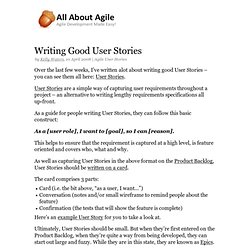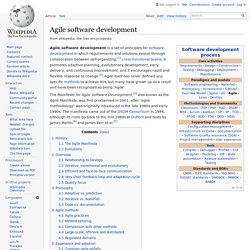

More Agile Process Information. Agile Alliance. Manifesto for Agile Software Development. Your Path through Agile Fluency. Agile methods are solidly in the mainstream, but that popularity hasn't been without its problems.

Organizational leaders are complaining that they're not getting the benefits from Agile they expected. This article presents a model of Agile fluency that will help you achieve Agile's benefits. Fluency evolves through four distinct stages, each with its own benefits, costs of adoption, and key metrics. For over twelve years, we’ve been leading and helping teams transition to Agile. The industry has changed a lot in that time. Throughout the next decade, Agile grew. The community grew, too. Growth hasn’t been without its problems. We’ve been helping teams transition to Agile since the beginning. The Agile Fluency™ model We’ve observed that Agile teams develop through four distinct stages of fluency. In the Agile Fluency™ model [1], we’re considering team fluency rather than individual or organizational fluency.
Each star brings specific benefits, and each involves new adoption challenges. Cleveland_PMI_Scrum.pdf. Adaptable Designs for Agile Software Evolution. “It is not the strongest of the species that survives, nor the most intelligent that survives.

It is the one that is the most adaptable to change.” – Charles Darwin Big Design Up Front (BDUF) is considered a very bad practice in Agile software development. BDUF is problematic because it assumes frozen requirements. The Agile approach is that software must be developed iteratively since the requirements will change and the system will evolve. So we need some Design Up Front, but this must be Adaptable design that supports change: ADUF.
Adaptable Design Up Front We should never work on the design of a specific system. Scrum Foundation. User Story Examples and Counterexamples. People who share my background in traditional requirements analysis often have a hard time coming up with Product Backlog Items representing thin vertical slices of potentially-shippable product.

Here are some good and bad examples that people have found useful. User Stories may assume template form (see User Stories Applied by Mike Cohn): “As a [role] I can [function] so that [rationale].” or expressed as noun phrase: “Image clipboard” or a 1-2 sentence story (ideally a testable assertion): “Busy streets are highlighted on the map.” User stories, like all Product Backlog Items, should contain or clearly imply acceptance criteria (definition of “done”). Bill Wake has given us the INVEST mnemonic to help remember the characteristics of a well-formed user story: I – IndependentN – NegotiableV – ValuableE – EstimableS – SmallT – Testable What does this look like in practice?
A bank customer can change his PIN. How do we know when we’re missing the mark? Writing Good User Stories. Over the last few weeks, I’ve written alot about writing good User Stories – you can see them all here: User Stories.

User Stories are a simple way of capturing user requirements throughout a project – an alternative to writing lengthy requirements specifications all up-front. As a guide for people writing User Stories, they can follow this basic construct: As a [user role], I want to [goal], so I can [reason]. This helps to ensure that the requirement is captured at a high level, is feature oriented and covers who, what and why. As well as capturing User Stories in the above format on the Product Backlog, User Stories should be written on a card. The card comprises 3 parts: Card (i.e. the bit above, “as a user, I want…”)Conversation (notes and/or small wireframe to remind people about the feature)Confirmation (the tests that will show the feature is complete) Here’s an example User Story for you to take a look at. Ultimately, User Stories should be small. . * Independent. . * Negotiable. . * Small. Scrum Foundation. Agile Software Development - An Introduction.
Scrumwise - The Scrum tool you've always wanted. The home of Scrum > Home. Scrum Training Series: Free Scrum Master Training. AgileSoftwareDevelopmentItsAboutFeedbackAndChange. 030-ICINT2012-I2069. Scrum (software development) Scrum is an iterative and incremental agile software development framework for managing product development.

It defines "a flexible, holistic product development strategy where a development team works as a unit to reach a common goal", challenges assumptions of the "traditional, sequential approach" to product development, and enables teams to self-organize by encouraging physical co-location or close online collaboration of all team members, as well as daily face-to-face communication among all team members and disciplines in the project. A key principle of Scrum is its recognition that during a project the customers can change their minds about what they want and need (often called "requirements churn"), and that unpredicted challenges cannot be easily addressed in a traditional predictive or planned manner. Later, Schwaber with others founded the Scrum Alliance and created the Certified Scrum Master programs and its derivatives.
Each sprint is started by a planning meeting. Agile software development. Agile software development is a set of principles for software development in which requirements and solutions evolve through collaboration between self-organizing,[1] cross-functional teams.

It promotes adaptive planning, evolutionary development, early delivery, and continuous improvement, and it encourages rapid and flexible response to change.[2] Agile itself has never defined any specific methods to achieve this, but many have grown up as a result and have been recognized as being 'Agile'. The Manifesto for Agile Software Development,[3] also known as the Agile Manifesto, was first proclaimed in 2001, after "agile methodology" was originally introduced in the late 1980s and early 1990s. The manifesto came out of the DSDM Consortium in 1994, although its roots go back to the mid 1980s at DuPont and texts by James Martin[4] and James Kerr et al.[5] History[edit] Incremental software development methods trace back to 1957.[6] In 1974, E.